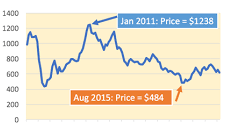Management > Managerial Statistics > Construction of Index Number
Following are the steps involved in the construction of index number
Purpose of index number:
The steps which are taken in the construction of index number generally depend on the purpose of the index number. Hence the purpose of index numbers must be defined clearly, perfectly and unambiguously. There are various types of an index number, constructed with different objectives. Thus before constructing an index number, one must define the objective. An index number, which is designed keeping, the specific objective in mind, is a very powerful tool. For example, an index whose purpose is to measure consumer price index, should not include wholesale rates of items and the index number meant for slum-colonies should not consider luxury items like A.C., Cars refrigerators, etc.
Selection of base year:
Selection of base year is another problem in the construction of the index number. The index number for a particular future year is compared against a year in the near past, which is called a base year. It may be kept in mind that the base year should be a normal year and economically stable year. The period of abnormalities should not be considered as the base year. The base year should not be too distant in the past. Base year should be that year for which reliable figures (data) are available.
There are three types f base periods.
Fixed Base (A Single-Period): In a fixed base, the base period must be a normal period. A normal period means that the period must be free from all sorts of abnormalities of random causes such as financial crisis, floods, famines, earthquakes, strikes of labourers, wars, etc.
Fixed Base (An Average of Selected Periods): When it is difficult to choose one single period as a normal, then a better choice is to take an average of several periods as a base.
Chain Base: If the comparison is a required year on year, a system of chain base is used.
Selection of goods and services (Commodities):
After the objective of construction of index numbers is defined, only those items which are related to and are relevant with the purpose should be included. The consumption pattern of consumers might change and thereby make the index number useless. It is better to use a consumption pattern at the time of the setting of the index number. Guidelines for the selection of commodities are as follows:
- The number of commodities should neither be too large nor too small.
- The commodities to be selected must be broadly representative of the group of commodities.
- Selection should contain Standard or graded items and there must be no significant variation in the quality.
- Selection should represent the real tastes, habits, and customs of the people.
- The selection must be easily recognizable.
- The selection should be tangible.
- The economic and social importance of various items should be considered
- All those varieties of a commodity which are in common use and are stable in character should be included,
Selection of price:
Whether wholesale or retail prices to be used is also a problem in the construction of index number. For a consumer price index, wholesale prices are required, while for a cost of living index, retail prices are needed. Care should be taken to avoid mixing of the two types of prices. Care should be taken to select prices from representative persons, places or journals or other sources. But they must be reliable. Prices may be quoted in money terms. Guidelines for the selection of price are as follows:
- prices are to be collected from those places where a particular commodity is traded in large quantities,
- Published information regarding the prices should also be utilized but information should be reliable,
- The institutions supplying price quotations, should not be biased.
- Take care to consider wholesale price or retail price as per the requirement.
- Prices collected from various places should be averaged.
Choice of Average:
As index numbers are themselves specialized averages, it has to be decided first as to which average should be used for their construction of the index number. The arithmetic mean, being easy to use and calculate, is preferred over other averages (median, mode or geometric mean). The selection of average depends on the relative merits and demerits of the various averages. The average may be weighted or unweighted.
Selection of Weights:
While constructing an index number due weightage or importance should be given to the various commodities. Commodities which are more important in the consumption of consumers should be given higher weightage than other commodities. It is universally agreed that wheat is the most important cereal as against other cereals, and hence should be given due importance. The weights are determined with reference to the relative amounts of income spent on commodities by consumers. Weights may be given in terms of value or quantity. There are two methods for assigning weights.
Implicit Method: In this method, several varieties of a certain type of commodity under study are used. Such weights are called implicit weight.
Explicit Weight: In this method, the weights are laid down on the basis of one outward evidence or importance of commodities.
These weights may be fixed or fluctuating. The importance of commodities also changes with the change in the tastes and incomes of consumers and also with the passage of time. Therefore, weights are to be revised from time to time and not fixed arbitrarily.
Selection of appropriate Formula:
A number of formulas have been devised to construct an index number. But the selection of an appropriate formula depends upon the availability of data and purpose of the index number. No single formula may be used for all types of index numbers. After deciding all the factors appropriate formula (Fisher’s or Laspeyres) is selected to represent the data correctly.
Previous Topic: Introduction to Index Numbers
Next Topic: Index Number by Simple Aggregative Method
